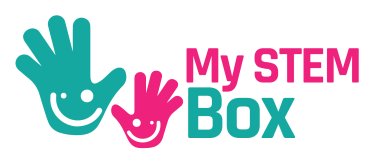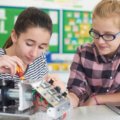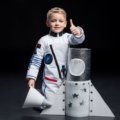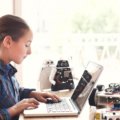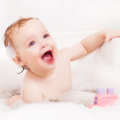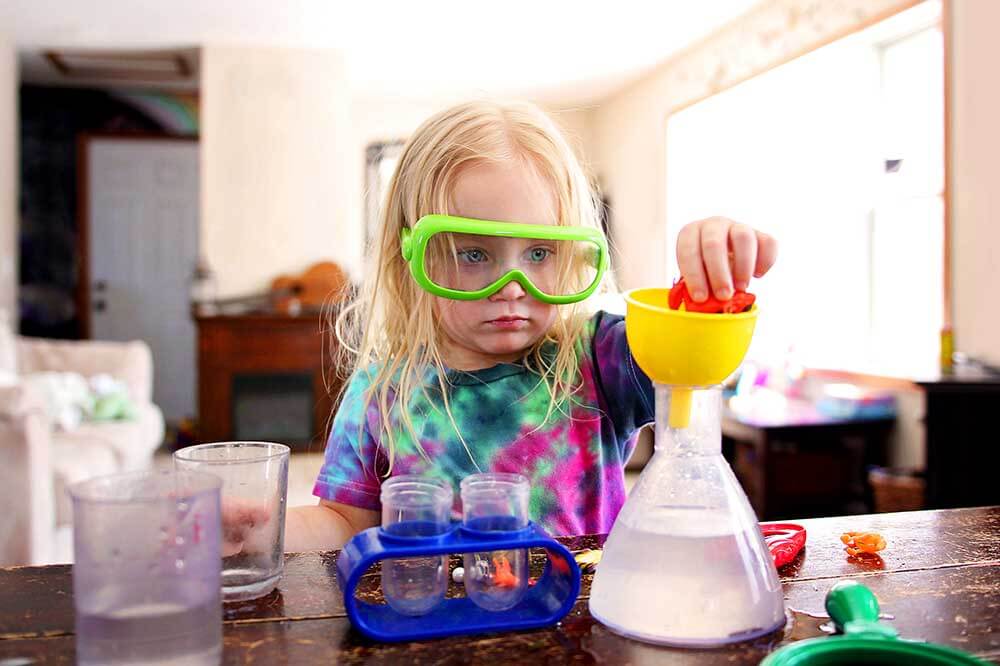We selected 30 of the best STEM books for kids of all ages that you can enjoy on drizzly and beautiful days. They offer children the ultimate start to investigative learning and that is so much more fun than via boring rules ... Transform your home or classroom with these books into a true laboratory and your children into real inventors!
Contents
Best STEM Books For Babies & Toddlers
Here we selected 3 STEM books for babies & toddlers. My son really enjoyed the book about our solar system when he was a toddler. But first the:
Here We Are: Notes for Living on Planet Earth (2017) by Oliver Jeffers is a beautifully illustrated book about living on Earth and being a good person. This book has some interesting facts about our world and it's quite magical to share those facts with your own child.
Little Scientist Board Book Set (2018) by MudPuppy is comprised of beautiful illustrated portraits of real women who have made historical impact on the world. The author really brought these big concepts down to an understandable level for kids with one or two lines on each page.
Hello, World! Solar System (2016) by Jill McDonald is a great book that my son enjoyed over and over. The book teaches toddlers all about the sun, moon, stars, and planets—with colors, shapes, sizes, and super-simple facts. Highly recommend this colorful and fun book!
Best STEM Books For Kids Ages 4 - 8 Year Old
Here you can find 20 STEM books for kids aged 4 - 8 years old. My son enjoyed a lot of these books, especially the ones with the STEM activities and the book about the human body.
Crafty Science (2018) by Jane Bull is a hands-on crafty science book that introduces inquisitive children to the wonders of science through 25 kids craft projects with everyday objects. And that's also the fun part: all the items that you find in and outside your house are used to teach kids about science with simple STEM activities.
My First Book of Planets: All About the Solar System for Kids (2020) by Bruce Betts. Kids can explore the entire solar system through beautiful photos and great basic information on what makes each planet so special―like their size, distance from the sun, what the surface is like, how many moons they have, and much more.
How Machines Work: Zoo Break! (2015) is a really special book with inspiring illustrations by the award-winning artist David Macaulay and packed with interactive elements such as press-out models, pop-ups, and pull-outs. You’ll find out how things work, from bicycles, cranes, and drills to diggers, hammers, and zips.
Groundhog Weather School (2013) by Joan Holub, illustrated by Kristin Sorra is a great book for kids that not only tells them fun facts about groundhogs, but about the weather in general. It's very engaging and has a lot of humor that adults will enjoy as well. It made me laugh a lot while I was reading it to my son! 🙂
How Cities Work (How Things Work) (2016) by Lonely Planet Kids is a book that teaches kids about skyscrapers, subway systems and stinky sewers. Discover where people live and peek behind closed doors to see what's going on in houses and apartments, or find out about what goes on underneath the streets we walk on every day.
Ask A Scientist: Professor Robert Winston Answers 100 Big Questions from Kids Around the World! (2019) by Robert Winston. The book answers 100 questions that children have asked. Some examples include the following: How does Velcro stick? When did time begin? Why does ice cream melt? How do we get taller? How does the moon affect the tides of the sea?
I am Neil Armstrong (Ordinary People Change the World) (2018) by Brad Meltzer is a friendly, fun biography about the first man on the moon. Not only the illustrations are wonderful in this book, it is also written really well. It's an inspiring book for all the young astronauts out there! 🙂
Counting on Katherine: How Katherine Johnson Saved Apollo 13 (2018) by Helaine Becker is an inspiring story about an African-American woman who dreamed big, and was an amazing mathematician. She was essential for space exploration and she saved the lives of astronauts by her work.
Shark Lady: The True Story of How Eugenie Clark Became the Ocean's Most Fearless Scientist (2017) by Jess Keating tells the true story of a young girl growing up to be a scientist.
Have Fun, Molly Lou Melon (2012) by Patty Lovell is an amazing book book that teaches children about the importance of using their imagination.
Going Places (2014) by Paul A. Reynolds is a picture book about a go-cart contest: make one, race it and win. Each kid grabs and scrambles to create an identical set. An inspiring book for young creators!
Ada Twist, Scientist (2016) by Andrea Beaty is a book about a really curious, adventurous, and very tenacious girl. She is eager to solve the enigmatic mysteries of life that surround her.
If I Built a Car (2007) by Chris Van Dusen is a great book about a little boy who designed a dream car. He comes up with great ideas, such as a car with a swimming pool and snack bar or a car that flies and can also go underwater like a submarine. It's fun to come up with car ideas with your own children while reading this book.
The Most Magnificent Thing (2014) by Ashley Spires is a wonderful book that teaches the importance of resilience. The unnamed girl in the book tries to make her magnificent thing and that process is anything but easy. She tries and fails, repeatedly and in the end she gets it just right. Note: this book can also be a great read for a bit younger children.
There's No Place Like Space: All About Our Solar System (1999) by Tish Rabe is a great book that stars Cat in the Hat from Dr. Seuss. Learn about the solar system, planets, the constellations, and astronauts, and explore the wonders of space. The book is really great for aspiring astraunauts, or any kid who loves learning and science.
Awesome Science Experiments for Kids: 100+ Fun STEM / STEAM Projects and Why They Work (Awesome STEAM Activities for Kids) (2018) by Crystal Chatterton. This book is packed with great STEM activities to do together with your kid(s). From learning how quicksand works to turning a lemon into a battery, the book teaches young scientists how cool it is to be curious.
Human Body Activity Book for Kids: Hands-On Fun for Grades K-3 (2019) by Katie Stokes. This book has been one of my son's favorite books. The older he got, the more he understood about it. It was always amazing to hear him talk to us or other people about the things inside his body that he clearly remembered from this book.
Awesome Kitchen Science Experiments for Kids: 50 STEAM Projects You Can Eat! (Awesome STEAM Activities for Kids) (2020) by Megan Olivia Hall is a book with lot's of great STEAM activities to perform in your kitchen: from flaming cheese puffs to solar-powered s’mores, discover tons of deliciously fun ways to explore science. I really like that each experiment has a difficulty rating and a rating for the amount of mess.
My Encyclopedia of Very Important Things: For Little Learners Who Want to Know Everything (2016) by DK is your children’s first encyclopedia with interesting facts about the world, animals, people, planets, and themselves.
My Book of Rocks and Minerals: Things to Find, Collect, and Treasure (2017) by Devin Dennie is a great visual reference book. For many years I've collected many rocks and minerals and once my son started asking questions about them, I purchased this book. He was thrilled to hear all the stories about the minerals in our house, and he is turning into a little geologist himself now 🙂
Best STEM Books For Kids Ages 9 - 12 Year Old
Here you can find 7 STEM books for kids aged 9 - 12 years old. I've given a few of them to my nephew who is really into science and he loves them so much. Especially the Nick and Tesla series below:
The Nick and Tesla Series (2016) by Steve Hockensmith and Bob Pflugfelder. Nick and Tesla are bright 11-year-old twins with a knack for science, electronics and trouble. They are sent to live with their Uncle Newt, a genius scientist who engineers top-secret gadgets for a confidential government department, when their parents mysteriously disappear. It's not long before Nick and Tesla embark on their own adventures, designing all sorts of outrageous MacGyverish contractions to save their skin: 9-volt burglar alarms, electromagnets, sensors for mobile monitoring, and more.
So You Want to Be an Inventor? (2002) by Judith St. George and David Small. Some of the world's best-known inventors are included in the book: Thomas Edison (light bulb inventor), Benjamin Franklin (lightning rod inventor and many others), Eli Whitney ("saw" cotton gin inventor), Wilhelm Roentgen (inventor of X rays). This book could just encourage readers to invent something that could change the world, whether you're a dreamer or a loner, a copycat or a daredevil!
Kate the Chemist Series (2020) by Kate Biberdorf, a science professor at UT-Austin. The books in the series are about Kate the Chemist: a ten-year-old science problem solver. The books are very fun to read, and for young kids who are interested in science, Kate is a perfect role model.
The Fantastic Flatulent Fart Brothers' Big Book of Farty Facts: An Illustrated Guide to the Science, History, and Art of Farting (2017) by M.D. Whalen. It's a fun book for kids - especially boys - who love bathroom humor. The book has serious facts about "bottom burps" but in a very humorous way.
The Boy Who Harnessed the Wind - Young Reader’s Edition (2015) by William Kamkwamba and Bryan Mealer. The books tells the tale of William Kamkwamba, the courageous young inventor who introduced electricity to his Malawian village, in a thrilling memoir of survival and perseverance. The original version of the book was a New York Times bestseller.
Girls Who Code Series (2017) by Stacia Deutsch is a New York Times bestseller. The book is perfect for anyone interested in computer science and this series is published in partnership with the organization Girls Who Code. This is the 1st of 4 books in the Girls Who Code series.
You not only learn about some of the coding's fundamental principles: variables, loops, inputs and outputs but you get to learn it in an interesting, mystery-based style. It can be for the fashion lover, the sports enthusiast, the girl trying to support a family member, the shy girl at a new school; the book can be used for anything as fun as pranking a sibling or as extreme as reminding a loved one coping with illness to take their multiple medications. You discover that coding can be for anyone and that possibilities are limitless.
Calling All Minds (2018) by Temple Grandin the world-renowned autism spokesperson, scientist, and inventor. It is a book that's part personal memoirs, part historical research on inventions and biography, and part instructions for DIY projects. The projects range from easy to moderately challenging and are age-appropriate and realistic.
As a parent of a five-year-old inquisitive boy, I have gained a lot of experience finding fun activities and toys to help him understand science and understanding our world in general. On this blog, you’ll find an extensive amount of tutorials, guides, and toys about Science, Technology, Engineering, and Math based on my personal experience to help your child develop critical STEM skills.
